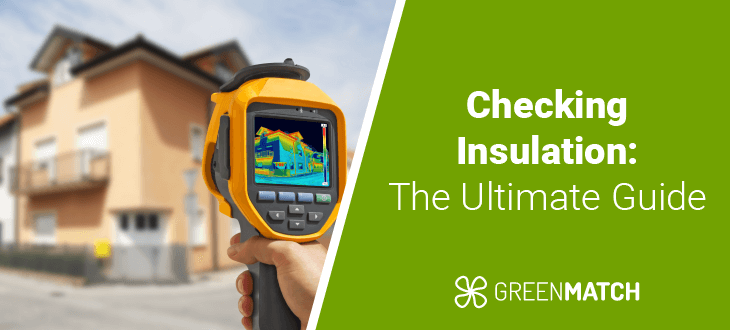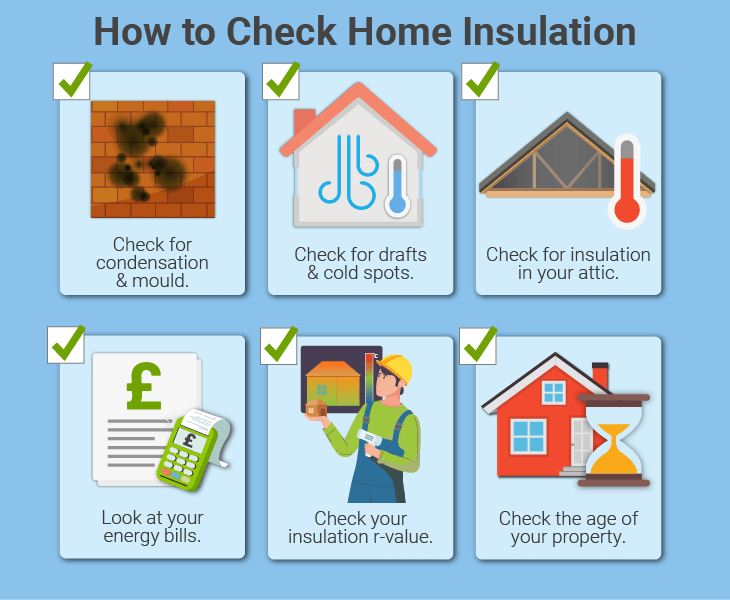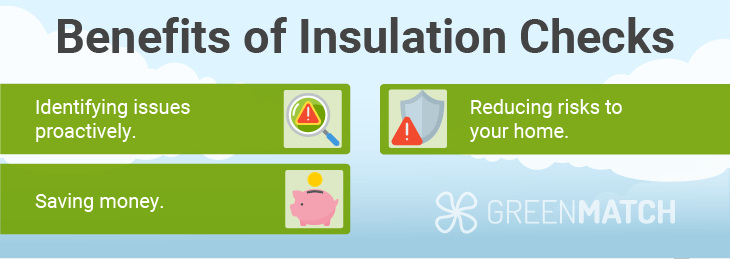Answer these simple questions and we will find you the BEST prices
Which type of solar quotes do you need?
It only takes 30 seconds
100% free with no obligation

Get Free quotes from insulation specialists near you

Save money by comparing quotes and choosing the most competitive offer

The service is 100% free and with no obligation
- GreenMatch
- Insulation
- Insulation Check
Insulation Check: How to Tell Your House Is Well Insulated


- A well-insulated house will have huge energy bill savings, a reduced carbon footprint, and a comfortable living environment.
- Issues like condensation, cold spots, and mould growth can indicate dysfunctional insulation that needs to be addressed.
- Uninsulated walls alone can lead to up to 30-35% of heat loss in a home.
The UK housing stock is notorious for being one of the most poorly insulated in the European neighbourhood. A 2022 study by the think tank Resolution Foundation (RF) showed that poorly insulated homes burn 58% more gas annually for heating than homes that meet insulation standards. This leads to staggering bills, carbon footprint, and uncomfortable homes.
Insulating your home is a great step, but how can you know if your insulation is functioning properly? Or does your home even have insulation, to begin with? This ultimate guide by GreenMatch UK will give you everything you need to know about insulation checks, including telltale signs of dysfunction, how to take care of insulation, and professional assistance.
Ready to insulate your home? Let GreenMatch UK be your one-stop solution for all your needs. By filling out our simple 30-second survey, you can get up to 3 free home-tailored quotes from our network of trusted installers. No charges or obligations. Click the button below to begin!
Fill in the form in just 1 minute
Ways to check if your home is well-insulated

To check if your home is well insulated, there are several things you can keep an eye out for. Generally speaking, the most telltale way to notice a poorly insulated home will be by spotting issues that may be taking place, such as mould growth or condensation.
Here are some tips on what to look out for when checking your home and insulation:
Check for condensation and mould growth
Wondering how to check if cavity wall insulation is wet? Or any insulation for that matter? If you are noticing window and wall condensation in your home or general dampness, this can indicate that there are issues with your insulation, home ventilation or likely both.
A poorly insulated home with condensation issues can lead to structural rot, and mould growth in your home. Not only does this risk the safety of your home, but damages your health by increasing the risk of respiratory illnesses like asthma.
If you notice minor mould growth in the shower, that may just be due to the constant exposure to dampness and can be fixed DIY, however, mould growth on walls and living quarters is a very high indicator of insulation issues.
Check for drafts and cold spots
If you wonder how to check insulation in walls, the best way is to pay attention to them. Areas where you can feel a draft, or cold spots on your walls can indicate poor insulation. Drafts indicate panel gaps and openings that need to be sealed, cold spots in walls and floors indicate insulation clumping or areas where the material is too thin.
Panel gaps and openings can be sealed with plaster or expanding foam, whereas cold spots suggest a more structural issue with your insulation that may need professional help. In most cases, a simple insulation top-up can do the trick. In case the insulation is damaged, it may require a full replacement.
Check for insulation in your attic
Curious as to why lofts should be insulated, or how to insulate a loft? Uninsulated roofs, lofts and attics are responsible for up to 26% of heat loss in a home, making them big culprits for high energy bills and indoor discomfort. A loft insulation check can ensure that your insulation meets the expected standard.
Look for the depth of your insulation, especially if you have a cold loft insulation job (i.e. your loft floor contains insulation). This material should normally be at least 270mm deep for optimal performance. If not, it requires an insulation top-up to meet the required standards.
Look at your energy bills
Perhaps one of the most telltale signs of dysfunctional insulation is sudden unexplained increases in your energy bills. By comparing your monthly and yearly consumption and costs, do you notice a drastic change?
If so, this increase can indicate that there is something wrong with your insulation and it is no longer insulating your property effectively. Contacting a professional for an insulation inspection would be the best step to take from here to identify the exact problem.
Check the r-value of your insulation
Each insulation material has an r-value, a quantifiable measurement that shows how effective a material is in resisting heat transfer. Materials have ideal r-values at their most optimal condition.
By arranging a professional insulation inspection, you can check to make sure your insulation is as effective as it should be. If the r-value indicates is much lower than the optimal function, it might mean your insulation is damaged or in poor condition.
The age of your property
The age of your property can give clues as to when was the last time your home was insulated. The general lifespan of each insulation material may be different, it’s a rule of thumb that insulation should be inspected and topped up every 15 to 20 years.
Insulation that is left uninspected for longer than 20 years may have lost its efficiency, become damaged, or experience issues such as clumping, moisture and mould growth. This insulation would need to be completely removed and replaced.
How can you tell if insulation is poor in your home?
In most cases, the poor function of insulation in your home will become apparent from the issues your home is experiencing. Problems such as excessive condensation and moisture, persistent mould, drafts, and cold spots all identify that something isn’t working as it should.
In these cases, the existing insulation material will almost always need to be removed and replaced, which in itself is a very costly process. Luckily, the UK government backs two grant schemes that can assist with full or partial funding for qualifying homes.
The Great British Insulation Scheme (GBIS) and the Energy Company Obligation (ECO4) both provide home upgrades to low-income and fuel-poor households. To apply for a home insulation grant from the GBIS, you can visit the official UK website and fill out an application form. For the ECO4, contact your energy provider to learn more.
How often should you check your insulation?
While durable and professionally installed insulation can sometimes last upwards of 80 - 100 years, it’s a rule of thumb that insulation should at least be inspected every 15 to 20 years.
That way, insulation issues can be identified and addressed proactively, before they become much larger issues and cause structural damage to your home.
By arranging an insulation expert to inspect your home every 15 or so years, even in the absence of problems, you can be one step ahead of maintaining your home's comfort.
Insulation check, professional or DIY?

Whether you can conduct a DIY insulation check or require a professional depends on several factors, such as the type of insulation in question, and where it is installed.
For example, loft insulation such as mineral wool or loose fill can generally be checked DIY and even topped up, but injected cavity wall insulation will almost always need a professional. Nevertheless, conducting a free insulation check with an accredited installer can bring about lots of benefits, such as:
- Identifying issues: Proactively finding problems before they become fully blown disasters for your home will help you save huge amounts of money in the long run. Addressing minor issues is always cheaper than repairing structural home damage.
- Save money: Instead of dragging out the lifespan of poorly functioning insulation, replacing it with new high-quality insulation will save you money in the long run.
- Reduce risks: Insulation problems that have persisted for a while can begin harming the very structural integrity of your home, leading to rot in floorboards, joists, rafters and beams, as well as heavy mould growth. This is not only disastrous for your savings, but also for your health. Proactive checks help avoid this risk.
With all things considered, finding the perfect installer can sometimes feel like looking for a needle in a haystack. Prospective customers often find themselves stuck in an endless cycle of surfing websites and scheduling phone calls with no deal in sight. GreenMatch UK can fix that.
By filling out our simple 30-second online form, you can receive up to 3 free home-tailored quotes from our network of pre-vetted installers throughout the UK. No charges or obligations apply. Just click the button below to begin!
Fill in the form in just 1 minute
FAQ
In most cases, insulation checks are best conducted by a professional assessment of your property. That way, issues can be proactively identified that you may not be equipped or trained to spot. For certain insulation jobs, such as loft underfloors, you may be able to check DIY.
Most of the time, there will be telltale signs of poor insulation performance from the condition of your home. Excessive moisture and condensation, mould growth, cold spots, and drafts are some of the signs to look out for that may indicate compromised insulation.
A good way to check the performance of your insulation is to check your energy bills. If they remain stable or have even gone down since you got insulation in place, chances are they function just fine. If you tend to notice drastic increases in your bills, it’s safe to say there may be an issue.
While insulation can last up to a century in some cases, it’s advised to check your insulation with a professional every 15 to 20 years. That way, you can keep it up to the condition it needs to be in to insulate your home effectively.
The minimum insulation requirement in the UK depends on what you are insulating, but for lofts, it’s generally a thickness of at least 270mm of mineral wool or a similar blanket-style insulation.

Akif is a copywriter at GreenMatch since 2023. With a keen interest in community sustainability, green solutions and the role of digital media in identifying climate trends, he aims to hone in on his background in International Studies and Digital Media to provide a multidisciplinary approach to written content rooted in credible research and accuracy.
We strive to connect our customers with the right product and supplier. Would you like to be part of GreenMatch?

